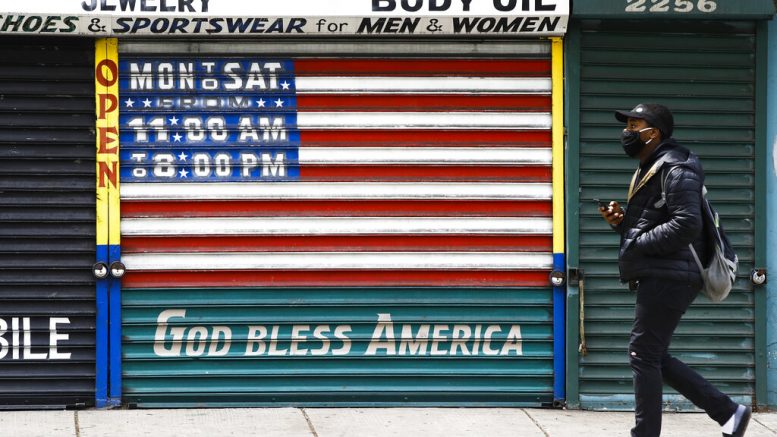HARRISBURG (AP) — The administration of Gov. Tom Wolf cautioned Thursday that a declining case count is just one factor that officials will consider in deciding whether a region of the state is ready to begin emerging from the pandemic.
Wolf’s reopening plan divides counties into six geographic regions, where shutdown rules may be relaxed once fewer than one person in 2,000 has been infected over the past two weeks.
Wolf said he believes two regions — the northcentral and northwest, both of which have seen relatively few cases — will be ready for a limited reopening on May 8, with residents permitted to leave their homes at will, and some retail shops allowed to accept customers.
But the case count isn’t the only metric, officials said Thursday. The availability of diagnostic testing, the capacity of the health care system and the ability to quickly identify and contain flareups through what’s known as contact tracing will also play a role. The state health department will also use a new modeling tool by Carnegie Mellon University.
A manageable number of new virus infections each day will be “very important, it’s something we can measure and put down on paper, but it’s not the only measure that we’re going to be looking at,” said the state health secretary, Dr. Rachel Levine.
Even in areas where some semblance of normalcy returns, Levine said she still wants people to wear masks in public and to keep their distance from each other to help prevent a resurgence of the virus.
Wolf, in a separate briefing, predicted that Pennsylvania’s hard-hit southeast region will be the last to emerge from pandemic restrictions.
The Wolf standard is more stringent than reopening guidelines issued by the White House, which only call for a downward trajectory of documented cases over a 14-day period. Wolf, a Democrat, is under pressure from GOP lawmakers to open up more quickly and more broadly.
Other coronavirus-related developments in Pennsylvania:
DEATH TOLL SLASHED
The Pennsylvania Department of Health slashed the state’s COVID-19 death toll on Thursday by 201, saying probable deaths it had previously included in the count were eliminated after further investigation.
The overall death toll now stands at 1,421, down from 1,622 reported a day earlier.
The number of deaths confirmed by a positive virus test actually rose overnight by 69, to 1,394. But Levine said Thursday that 270 probable deaths that had been added to the death toll in recent days have been removed after further investigation.
“This verification process is very intensive and under normal circumstances it can take months to complete,” she said. “We continue to refine the data that we are collecting to provide everyone this information in as near time as we possibly can. This is really difficult with thousands of reports each day.”
State health officials had recently changed the way they count COVID-19 deaths — now including probable deaths along with confirmed deaths — which resulted in a doubling of the state’s death toll in just four days. A probable death is one in which a coroner or medical examiner listed COVID-19 as the cause or contributing cause, but the deceased was not tested for the virus.
Officials have said they are trying to reconcile data provided by hospitals, health care systems, county and municipal health departments and long-term care living facilities with the department’s own records. Some county coroners have accused the state Department of Health of botching the numbers.
Statewide, more than 1,369 additional people tested positive for the virus that causes COVID-19, bringing the statewide total to more than 37,000, the health department reported Thursday.
CONTACT TRACING
Levine said a state plan to do contact tracing to limit the impact of COVID-19 infection is in the works and will rely partly on volunteers.
She said much of the work will be done by public health nurses, along with county and municipal health departments, hospitals and health systems.
Levine said it will also use volunteers.
Contact tracing, which identifies the people that COVID-19 patients have been in contact with, locates those who may be infected so they can be tested and isolated.
Levine did not say when the plan will be released, but a Department of Health spokesman said the agency is starting that work in areas where stay-at-home orders may be lifted first.
The department is still trying to determine exactly how many people will be needed, the spokesman said.
But, he said, with 1,200 new cases per day in Pennsylvania, it would take 7,200 hours each day to conduct contact tracing if each case involves 10 people who were potentially exposed. That would take 600 workers dedicated to contact tracing, he said.
CURBSIDE LIQUOR SALES
Pennsylvania’s state-owned liquor stores have processed about 25,000 curbside orders since that program began on Monday, for sales totaling about $2.3 million, the agency said.
The Pennsylvania Liquor Control Board said Thursday that its online order system also continues to expand its reach, from about 4,000 orders a day last week to more than 33,000 daily since Saturday, with five-day sales of more than $3 million.
More than 100 of the agency’s nearly 600 stores are currently filling online orders for delivery as well as curbside orders by appointment.
The online ordering system has been able to meet just a fraction of the public demand in Pennsylvania, where the stores retail nearly all hard liquor and much of the wine. Before the COVID-19 shutdown, the liquor stores handled about 180,000 transactions a day.






































